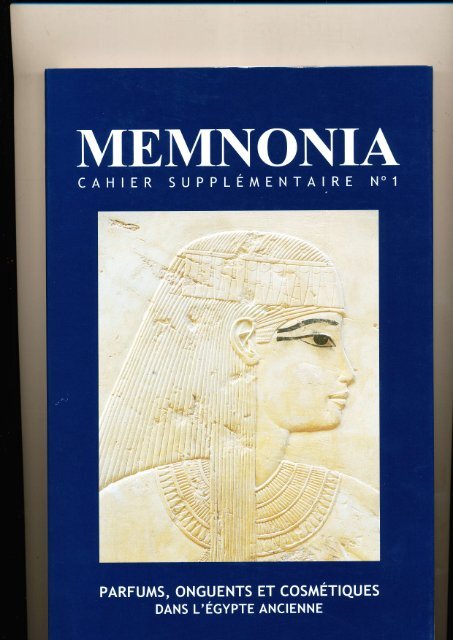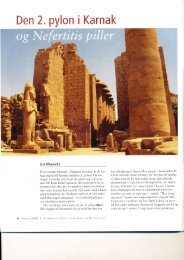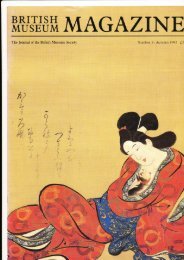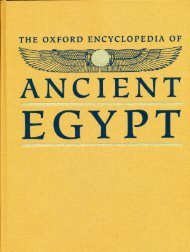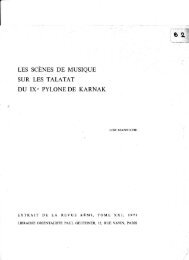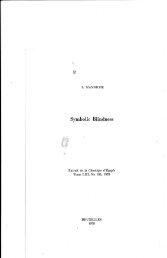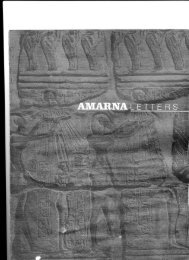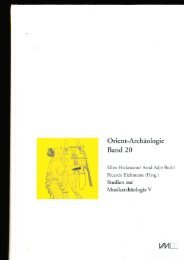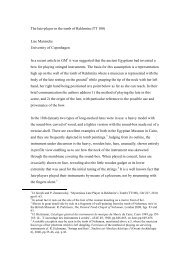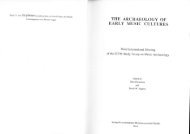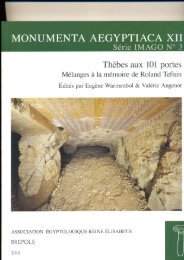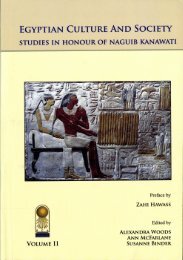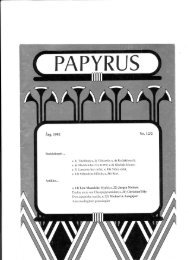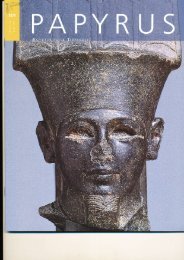Create successful ePaper yourself
Turn your PDF publications into a flip-book with our unique Google optimized e-Paper software.
1<br />
-; €<br />
t{<br />
fl<br />
t<br />
f,<br />
ANCTENT SCENT - AN EVALUATTON OF THE SOURCES [Pl. I-II]<br />
<strong>Lise</strong> MANNICHE*<br />
According to the Roman writer Pliny of the 1" century AD,<br />
"perfumes serve the purpose of the most superfluous of all forms of luxury ;<br />
for pearls and jewels do nevertheless pass to the wearer's heir, and clothes<br />
last for some time, but unguents lose their scent quickly, and die in the very<br />
hour when they are used." Furthermore (he adds) "all fthe money] is paid for<br />
the pleasure of someone else, for a person carrying scent about him does not<br />
smell it himself' (').<br />
It is through the classical writers that we obtain the most detailed<br />
descriptions of ancient scents, both their composition and their effect.<br />
Fortunately for us, they often quote Egyptian sources. However, the fact that<br />
these writers came from a different geographical and cultural background,<br />
that they did not speak the Egyptian language, and that they were also<br />
removed in time from the pharaonic Egyptians, allows for many<br />
misunderstandings and "re-interpretations".In this brief presentation I would<br />
like to assess the source material at our disposal, including both primary and<br />
secondary sources, and to point out some specific problems encountered in<br />
the quest for "the most superfluous of all forms of luxury" rzr.<br />
LEXICOGRAPHY<br />
A number of prescriptions for the manufacture of scented<br />
substances have survived. The most detailed are those written down on the<br />
walls of the so-called laboratories (3) in the temples of Philæ (o) and especially<br />
Edfu ('), along with the references in the texts of the temple at Dendera (6).<br />
Some parallels may be found in earlier sources, such as the medical texts, but<br />
the Ptolemaic material is by far the most explicit. In addition, we have Greek<br />
versions of some of the recipes (').<br />
The main, and at times unsurmountable, problem here is of a<br />
lexicographical nature. How do we determine the ingredients and translate<br />
the words? Some are known from other contexts. or we know the general<br />
* <strong>Lise</strong> MANNICHE est Professeur d'6gyptologie å I'Universit6 de Copenhague.<br />
..i
MEMNONIA<br />
-i"tå"t-i"tin"<br />
in the case of ttr"<br />
(frankiricånse, myrrh, etc') there is an<br />
nature of them through the use of the hieroglyphic determinative' though as<br />
onsoing discussion as to the exact significance of the terms (')' The ancient<br />
il?;tffi;å"r';t;", *"r" sometimei in doubt and added glosses to clarifv<br />
a specific term - t*"!*u.npi"*ft"tt the expression "fresh Horus eye" in one<br />
åiitt" Edfu texts is explained by "wine"'<br />
Inotherinstancesaningredientissounusualthatitisdifficultto<br />
grasp - as when t*lf p^tt is annllently a,base for a scented<br />
.used .as<br />
substance. This rs the case. for exampl.' *itrt the best documented scent of<br />
all,lqphi,known t ål-åJfL, Fhilu", ifuiu..^ (who c_opied from Manetho)(e),<br />
Galen (r0), Dioscorides(") 'iipni and even ,our.., going backiothe beginning of the<br />
New Kingdom (,,). *^t intended to ie birrnt (cf. Pl. I), or even taken<br />
as a remedy ugui#t;;åtft; una itr main ingredient appears to be -<br />
raisins.Furtherbackintime,sycamorepaste]ilasusedasabaseforscent,<br />
mixed with other;;"gtil ågredients i'". Wh"n comparing different<br />
recipes for kyphi,*""fltAt th"at there is considerable variation in the plant<br />
material added to the basic ingreAients, and cardamom. may be.substituted<br />
forcinnamonandcassiaforpine'"'in.Hence,forlexicograptric{:j:3,'..:<br />
they are nor as<br />
"r"i"i u, one'would perhaps have expected when searchlng<br />
for Greek equivalents to Egyptian terms. For these reasons it is not possible<br />
to produce u,t ;*;'åi. lwnl'i'.As in the case of another<br />
"*å.! ^.1t9i3tt<br />
intangible aspect of Egyptian civilisation ltheir music - we can only gain a<br />
seneral idea, and evån the egyptian-tfremselves would have recognised<br />
åifferent kinds. Edfu provides two ,".ip"r, and classical authors mention a<br />
wntqphi and a moon WPhit'o''<br />
Theworldwidemediacoverage,inthespringof2002,ofthe<br />
recreated typhiO"-.rrt "t"s<br />
the dile;å'; ;; i;;"''Sixtåen ingredients for<br />
kyphi are quotei.i; ;j;Fi, 4:<br />
and Philae' As has previouslv been<br />
pointed out "'', #tnese are fairly certain : raisins' wine and honey ;<br />
"rgfti by the name of<br />
mvrrh and frankincense: prne resrn'.f.t"1n"t and<br />
'iiåår"iiitil*^ii"itired'in 1 a jar<br />
lt1t<br />
wiih the name on) 'tor. Three plants are<br />
,,probably correcJ"i;;;;ft"g, åum"1 grass/lemon gr.als and cyperus grass)'<br />
Bur that leaves ti". pioUie"åatic in-gredients, which even vary among<br />
themselves. In the Greek text one nu? u""n rendered as cardamom' This<br />
could be a translåil* åi,n" Egyptian word (which some scholars translate<br />
cinnamon (1?) 1, o, ir"Åi;;; ;;;åstitute fo-r ån ingredient which was either<br />
unknown, urruuuliu^tf",å ini"rl*. The iewly recreated version of<br />
""rtiO"r"a<br />
t yphiis based on iui'i"' and honey' but for some reason wine was replaced<br />
bypalmwine.Thethreeresinsaremyrrh,frankincenseandmastic'theherbs<br />
being juniper' Iemon grass, giass'<br />
"ypg*t<br />
.sweet<br />
flag and mint' Cassia<br />
(mentioned by Galenf was preferr"d to cinnamon år cardamom. The
ANCIENT SCENT<br />
problematic aspalathos was interpreted as bois de Rhodes, and sesili was<br />
omitted, as was perhaps also chaerophyllum(r8). Even if we identify the<br />
plants^correctly, there remains the quåstion of the exact species and which<br />
pat of the plant was used : stem, leaves, flower, root, seeås, or fruits, juice<br />
or resin. In many instances this makes a difference.<br />
other scents used by the elite, rather than in the temple, were so<br />
famous in the Mediterranean that a Greek translation from the hieroglyphic<br />
original was required for it to be manufactured locally, but asaii -tir"."<br />
remains the possibility that an unfamiliar ingredient, whiåh was aiailable in<br />
Egypt, was replaced by another in Greece oi at Rome.<br />
Attempts at recreatingkyphi have been made before :<br />
-by<br />
-for<br />
-for<br />
-in<br />
-in<br />
-in<br />
a company in New Mexico c. 2000.<br />
an exhibition in the National Museum in copenhagen in 199g.<br />
an exhibition in Munich in Germany in 1990.<br />
1887 by Victor Loret and a French pharmacist.<br />
the 1850s by a chemist in Berlin (at which time it was marketed as an<br />
aphrodisiac).<br />
the Middle Ages by an unguent-maker<br />
Nikolaos.<br />
ICONOGRAPHY<br />
fromAlexandria by the name of<br />
Scent and perfume is not usually visible - if we disregard the<br />
luxurious wrapping in which these substånces are presented and- ffaded,<br />
nowadays as well as in antiquity. Nevertheless, the visual arts have some<br />
bearing on a discussion of the nature of pharaonic perfume, for the artists<br />
f*ld a way of signalling to their contemporaries, aid to us, that scent was<br />
of the utmost importance, not only duringlhe hfetime cif the Egyptians (as a<br />
matter of course), but also in their funerary beliefs.<br />
This is most evident in the wall decoration of the tombs of private<br />
individuals beginning during the old Kingdom and reaching its climai in the<br />
New.Kingdom. In the_ 3'd dynasty, Hesire had his unguent c-upboard depicted<br />
in his mastaba tts). In the 6'h dynasty there is i very lårge picture of<br />
Ptahshepses sniffing a pot of unguent at close hand, and in th; 1å* dvnastv<br />
participants at banquets are anointed as we watch. This is also the case when<br />
an official is rewarded by the king, for example in several tombs at el-
MEMNONIA<br />
Amarna. As in those days perfume was not based on alcohol, but on oils or<br />
fats, a heavily anointed peison would also have been quite greasy_, and.this<br />
state of affaiis would leåve traces on his or her garments' The white linen<br />
would have dark stains where it was close to the body, as at the breasts,<br />
shoulders or knees. In order to show a true abundance of scent, the artist<br />
would place a whole lump of unguent on top of the heads or wigs of the^<br />
guests (cf. Pl. [). This hai in the past been interpreted as an actual cone of<br />
inguent, but there seems now to be some consensus (20)inregarding.it as a<br />
viJual aid, provided by the ancient artists to remind us of the odoriferous<br />
ambiance --the significance of which will be demonstrated below.<br />
ANALYSIS<br />
Apart from studying the recipes and overcoming lexicographical<br />
problems, the most obvious approach towards an assessment of ancient scent<br />
would be to carry out analyses of residue in perfume containers. Recent<br />
results of such anålyses of eye-paint in the Louvre gave surprising results, in<br />
that it proved that knowledge of chemistry was far more sophisticated,than<br />
had pr^eviously been believed. Similar work on scent, using all_available<br />
modårn technålogy, is curently being continued in laboratories in France ('').<br />
The most important find of all, the perfume from the tomb of<br />
Tutankhamun, was anålysed at the time of its discovery - but science has<br />
advanced somewhat since the 1920s! It has been estimated that about 350<br />
litres of scented oil and fat were buried with him. When the second wave of<br />
robbers entered his tomb shortly after his burial, they brought leather sacks<br />
to caffy it all away. Apparently they were interrupted, leaving the alabaster<br />
jars wiih their necks broken and their interiors showing fingerprints, where<br />
ihey had scooped out the contents. Nevertheless, a substantial amount of<br />
scent was left. Even today residue is clearly visible inside the jars as they are<br />
exhibited in the museum. The analysis of one jar with 450 g scent in it was<br />
not surprising: 87 .77o fatty matter, probably animal fa1, t!9 rest being "some<br />
balm oi resinl' (22). The scented substance from the tomb of Tutankhamun still<br />
gave a faint odour, which has been variously described as coconut or flowers<br />
of broom or valerian.<br />
One may compare this ancient analysis with another from the 1980s<br />
of a tiny sample of the tissue of the mummy of Ramess_es II, which through<br />
pollen ånalysis alone yielded a truly amazing glimps-e of ancient vegetatior :<br />
ihe royal mummy had apparently been anointed w-ith gamomile oil, and this<br />
.u-oåil" had grbwn in a field full of weeds, all of which were identified (")'<br />
I am convinced that the next major step forward in research on ancient
ANCIENT SCENT<br />
perfume lies in the analysis of such physical remains<br />
belonged to the elite - if not to royalty.<br />
vessels that<br />
CULTURAL CONTEXT<br />
The significance of perfume in its cultural context in Egypt is<br />
becoming more clearly defined. From the beginning of Egyptian history<br />
there is evidence of the importance of scent and cosmetics in funerary beliefs<br />
and temple ritual. The most famous palette of all, the Narmer palette, was<br />
possibly used during a ritual, but we do not know what, nor do we know<br />
whether it involved eye-paint or scent. What we do know is that it was found<br />
in a "mixed layer" in the temple at Hierakonpolis, and that its decoration<br />
suggests a context which is either bellicose or is in some other way political.<br />
Private individuals were given sachets of eye-paint as tomb equipment, and<br />
the "seven sacred oils", each distinguished no doubt by their scent, their<br />
consistency and their rtrythological context, became a required element in<br />
funerary equipment of the historical period.<br />
The significance of scent in funerary beliefs is truly understood<br />
only when seen in the context of the symbolism of tomb equipment and tomb<br />
decoration, and the metaphors used in text and pictures to create an ambiance<br />
that would further the idea of rebirth in the hereafter. The Egyptians wanted<br />
eternal life. New life, rebirth, required the same elements as the original<br />
birth, that is to say sorne sort of sexual activity, or at least the presence of<br />
sexual powers. These, as we all know, are enhanced by scent and cosmetics,<br />
and by an abundance of hair, in Egypt emphasised by the use of wigs. When<br />
studying the tomb paintings of the Old, Middle and New Kingdoms and the<br />
very sophisticated ideas expressed by means of plays on words which are so<br />
beautifully and so clearly presented to us, there can be no doubt that funerary<br />
beliefs were very closely related to sexual concepts of daily life. This is why<br />
we can legitimately say that funerary beliefs and practices enlighten us on<br />
aspects of daily life, for it works both ways. This has been clearly<br />
demonstrated in the plays of words relating the concept of procreation to a<br />
visual pun of pouring out a drink. One may recall the word-plays used to<br />
explain the creation of the world, and the visual puns so abundantly<br />
presented by the artists become clear in so-called scenes of daily life :<br />
banquet scenes, fishing and fowling, hunting and so on ('o).<br />
These very Egyptian concepts and their emphasis on sexuality must<br />
be borne in mind in any discussion of the significance of scent and<br />
cosmetics. This is something that painstaking work by a number of scholars<br />
has revealed. The classical authors, some two thousand years closer to the
86<br />
MEMNONIA<br />
action than we are, were unaware of this. In the works of Theophla,stup'<br />
Fliny, Galen, and Dioscorides, we have isolated recipes, very _valuable<br />
in<br />
theii own right, but they do not enlighten us as to the cultural context in<br />
which the freparations were used. -"The Egyptian", "The Mendesian",<br />
Surinu-, Såmpsuchum, Amarakinon - very evocative lames, and so they<br />
would have been among the upper classes of Athens and Rome, imported or<br />
manufactured accordin! to fotbigtt recipes to delight,-but only that - like any<br />
souvenir torn from its -proper context, as wele the foreign scents imported<br />
into Egypt : Djefti and linbl from Alasia, best quality Kadiawar from Khatti,<br />
r"r..t"någ oif from Amor, Gati from Takhsi and ben (moringa)-oil from<br />
Naharin -<br />
as mentioned in one of the students' letters from the late New<br />
Kingdom. We may quote Pliny once more on the demand for foreign scents<br />
in A"rabia, importåd irom abroad : "so tired do mortals get of things !!t{. q'<br />
their own, and so covetous are they of what belongs to other people" (t5)'-In<br />
Athens of the 4'h century BC "Thå Egyptian" was one of.the most popular<br />
p"ifu-"t, consisting of a colourless base oii with the addition of cinnamon<br />
ånO mynir sreeped in wine, ideally matured for eight-years. In Egypt itself,<br />
it would seem that nothing surpåssed the delicate fragrance of the lotus<br />
flower, but its popularity" *ould huue had as much to do with its<br />
Åyttroiogl"al bactgiound as womb of the sun g_od aj the moment of its<br />
cråationånd, in adåition possibly, an awareness of the interesting medicinal<br />
(sexually stimulating) properties of the lotus (26)'<br />
The exploration of the world of ancient scents is just beginning- It<br />
requires ,.u..ui sciences to come together: lexicography,_ iconography,<br />
poil"n analysis, chromatography ånd chemistry, and a thorough<br />
inderstanding of Egyptian "ultute<br />
and its ways of communicating. By<br />
"Åpl"Vi"g ali of theiå, we shall begin to understand "the most superfluous<br />
of all forms of luxurY".<br />
R6sum6<br />
Research into what was by the Roman writer Pliny called "the most<br />
superfluous of all forms of luxury" should focus on four main areas : 1)<br />
lexicographical studies to define more closely the-- ingredients used in<br />
p."puåtiåns mentioned in prescriptions on the walls of Graeco-Roman<br />
t.*pf.r ; 2) iconographical studies of scenes where perfumed unguent is<br />
;pph.J or inerwlJe råpresented by artists lhe<br />
; 3) analyses of samples from<br />
scent conmlnefs ln -rråu-r,<br />
using the most fecent scientific equipment and<br />
methods ; and 4) a study of culturål context in which perfume and unguents<br />
appear in representatioÅ (during temple ritual, as a royal reward to officials,<br />
ur'u used in daily life und' above all, as a significant part of<br />
funerary "o-*ådity equipment and beliefs).
ANCIENT SCENT<br />
8l<br />
cFåil''<br />
JS s." a*t * )X)1 JftJl j,_*JiA,r'Ly>Jl -.il(Jl al,,,, L$ e.Jt _,Sj-c<br />
,,.?! cJK ",i<br />
.a+-t6r;9t* +n;i C,Jc C'qjt Jtsål<br />
c,Lb31 æ ø!Jt.:,ojl c.ly-;*Jl c,L:SJ ,}^ri ."lg d! *r+ a14* i.-l;r - '\<br />
.<br />
4s I " o:rj I - aå,Åy! J+ t rJ I c-r<br />
l-r-r+ .,Jc. ; r:+:J I<br />
.LeJto-.:,.,1 erfrliS &_si ;JÅ-Jl c,t La-rJl t{iå c.L",:-l ;Jl .ral .:,JJ 4#9"J1 +-11r -Y<br />
g,1 ;::tt c,-si ;1t*-:*!, ,-U^lt ,*-g;++/1JJÅJ1 elsl e;!ÅiJl ":ti*rjl J+l,i -'r<br />
'k3'lY<br />
L*JiLll J),l'i) .rL3*;Jl c,i;;ÅrJl .:t-,La,rJl +*u,-'t
88<br />
MEMNONIA<br />
(7) S"" references \n Sacred Luxuries, passim'<br />
(8) g. g. M. Chermette and J.-C. Goyon, "Le catalogue raisonn6 des producteurs de styrax et d'oliban<br />
d'Edfou et d'Athribis de Haute Egypte" in sAK23,1996, pp.47-82 ;N. Baum "L'organisation du rdgne<br />
y1getal dans l'Egypte un"i"nn"i, ln S. Aufrdre (6d.), Encyctopddie religieuse de l'univers våg6tal,<br />
Montpellier, 1999, PP. 421-43.<br />
(9) oe Iside et osiride,Sl.<br />
(10) oe antidotis, II,2.<br />
(ll) oe materia medical,25.<br />
(12) See Sacred Luxuries, chapter 3.<br />
(13)<br />
l. O. S. pendlebury and al., City ofAkhenaten,IlI, London 1951, p. 175 (no. 306).<br />
(14) Puulu. Aegineta, Epitomae medicae libri septem,yll'22'<br />
(15) U. Berrd,<br />
,,1 kuphi e i suoi ingredienri (I)", EVO 14115 (1991-92), pp. 43-53' Previous literature<br />
on kyphi includes the study by V. Loret in Journal asiatique i0, July-August i887, pp' 16-132 ;P'<br />
Derchain, "La recette du kyphi", rn RdE 28, 191 6, pp' 61-65 '<br />
(16) me pot with its contents was found in the tomb of Tutankhamun. The identification is cited by<br />
R. Germer, Flora des pharaonischen Ågypten, Mainz am Rhein' 1985' p' 143' cf' R' Germer' Dle<br />
pflanz.enmateriaLien aus dem Grab des Tutanchamøn, Hildesheim, 1989 (= HÅB 28), pp. 63-64'<br />
(17)<br />
s.", however, Germer, op. cit, p. 14.<br />
(18) Infor*ution kindly supplied by Isabelle Walter of l'or6a1'<br />
(19) See H. Alrenmiiller, "Das olmagazin im Grab des Hesire in Saqqara (QS 2405.)"' rn SAK 4,1976'<br />
pp. r-29.<br />
(20) pi.r, hinted briefly by S. Schott, Das schdne Fest vom Wi)stentale, Wiesbaden 1952' p' 75<br />
Pomade"). This was taken up by the present writer at a<br />
colloquium in Brussels in 1994 (see R. Tefnin ed., La peinture<br />
ancienne' (Jn monde de<br />
'gyptienne<br />
signei A pråserver, Brussels 1997, pp.33-34). The suggestion was further commented on by N'<br />
Clerpion, .,Le ,,c6ne d'onguent", gug" a" survie", in BIMO 94, 1998, pp.79-106, especially pp' 86-<br />
87.<br />
(,,aufgelegte - in wirklichkeit verriebene -<br />
(21) S"", for the time being, S. Aufrbre, "Apropos des r6sultats obtenus sur ies 6chantillons conserv6s<br />
au Museum d'histoire natirelle de Lyon", in S. Aufråre (6d), Encyclopddie religieuse de I'univers<br />
vågdtal, Montpellier, 1999' pp' 533-541.<br />
(22) J ournol of the Chemical Society 129, 1926, pp' 261 4- 2619'<br />
(23) L. Bulout and C. Roubet (eds.), L.a momie de Ramsås 11, Paris, 1985, pp. 162-165'
e<br />
)<br />
ANCIENT SCENT<br />
(24) S"" <strong>Manniche</strong>, "Reflections on the banquet scene" in Tefnin op. cir., pp.Z9-35; p. Derchain,<br />
"Symbols and metaphors in literature and representations of private life" in Roltal Anthropological<br />
Institute News 15, August 1976, pp. 7-10 ; W. Westendorff, "Bemerkungen zur "Kammer der<br />
wiedergeburt" im Tutankhamungrab", in zÅs 94, 1967, pp. 139-50. cf. also <strong>Manniche</strong>, sacred<br />
Luxuries, chapter 5 "Scent for love and rebirth".<br />
(25) Notrrot HistoryXXII, 78.<br />
(26) In on" of the off'ering texts in the Edfu temple the eyes of the deity marvel and his nostrils dilate<br />
when sniffing a lotus flower (M.L. Ryhiner, L'offrande du lotus dans les temples dgyptiens de l'dpoque<br />
tardive, Brussels 1986, pp. 31,43 and 53). A Tv6/Channel 4 television programme, broadcast in<br />
November 2000, quoted a laboratory in Manchester as proving that the blue lotus had properties akin<br />
to viagra. The narcotic properties of the flower had previously been suggested by W. A. Emboclen,<br />
"Transcultural use of narcotic water lilies in ancient Egyptian and Maya drug ritual", in Journal of<br />
Ethnopharmacology 3,1981, p. 58.<br />
6,<br />
t5<br />
le<br />
N.<br />
6-<br />
6s<br />
trs


